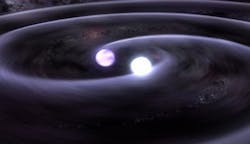Low-noise Andor CCD cameras help capture, analyze recent neutron-star collision
The recent confirmation of the existence and origin of gravitational waves via the Laser Interferometer Gravitational-Wave Observatory (LIGO) and the European VIRGO detector has led to the observation of a direct connection between these spacetime ripples and the violent collision of two neutron stars. In this new era of rapid-response astronomy, the gravitational wave signals enabled astronomers across the world to observe the merger of two massive neutron stars 130 million light years away at radio, optical, and x-ray wavelengths.
The camera technology of Oxford Instruments' (Abingdon, England) subsidiary Andor Technology (Belfast, Northern Ireland) is helping researchers understand more about what lies at the heart of this groundbreaking discovery; 25 deep-cooled low-noise Andor CCD imaging cameras are used in instruments across the world such as the Chile-based ESO telescopes, the Boyden telescope in South Africa, the Master global robotic telescopes network, and other sites. The cameras' large field of view and small pixel size help in acquiring the necessary data at the required resolution to be able to thoroughly explore the interactions that took place.
As part of the LIGO team responsible for discovery, Stephen Smartt of Queen's University Belfast has been coordinating the study of the properties of the newly observed event. Known as a kilonova, the neutron-star merger registered only as a faint glow on earth, representing the expulsion of radiation from the source at one fifth of the speed of light. Smartt and his team team have been studying the observed spectrum in an attempt to analyze the chemical makeup of the two stars and the resultant merger.
'Multimessenger' astronomy
"This is an unprecedented show of strength of modern international scientific prowess, collaboration, and technological advancement," says Marcin Barszczewski, Imaging Applications Specialist at Andor Technology. "Not only have we seen a very prompt and coordinated series of astronomical observations across the planet following the detection of gravitational waves, we can also appreciate how complementary it can be to combine a very novel detection paradigm with traditional optical as well as radio astronomy and spectroscopy in what is now firmly established multimessenger astronomy. These differing insights from various modalities, deployed in parallel, allow us a glimpse at the fate of two colliding neutron stars merging and exploding to create heavy elements that may one day coalesce to form new stellar or planetary objects."
For more info on this topic, see http://www.andor.com/astronomy.
Source: Andor

John Wallace | Senior Technical Editor (1998-2022)
John Wallace was with Laser Focus World for nearly 25 years, retiring in late June 2022. He obtained a bachelor's degree in mechanical engineering and physics at Rutgers University and a master's in optical engineering at the University of Rochester. Before becoming an editor, John worked as an engineer at RCA, Exxon, Eastman Kodak, and GCA Corporation.
